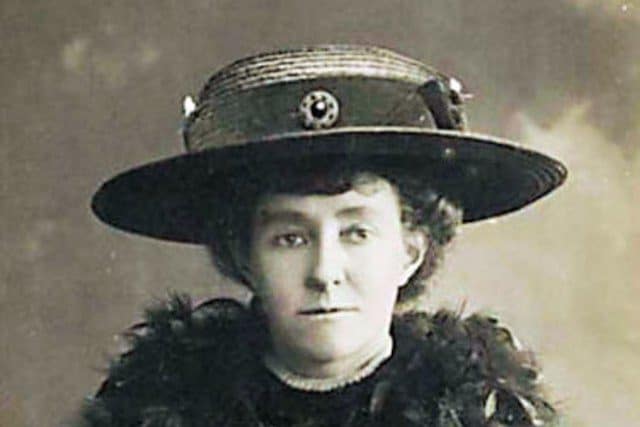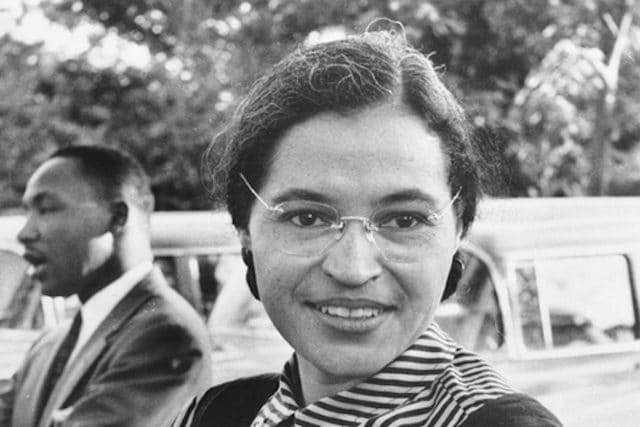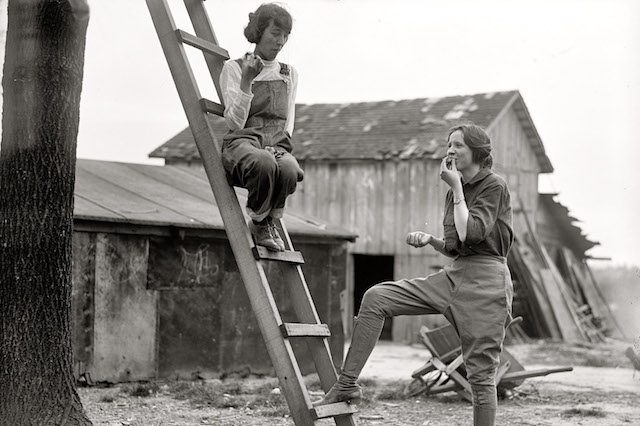When you think of the word “revolution,” you may imagine an uprising or a war fought by men. However, women were behind their own share of riots and demonstrations that lead to significant changes in society. Unfortunately, they are often forgotten by history for their acts of bravery. Here are 10 stories of revolutions led by women.
10. The First Human Civilizations

We will never know exactly what happened with human beings in prehistoric times, but anthropologists and archeologists have pieced together their ideas through cave drawings and artifacts. For roughly 90% of human existence on the planet, we were hunter-gatherers. It wasn’t until 12,000 years ago that people actually began to settle down and create civilizations.
Giving birth and being a mother while traveling in a hunter-gatherer society must have been incredibly difficult for women, especially while being pregnant or caring for newborn babies without a consistent source of shelter or food. It was the woman’s responsibility to forage for vegetation, while the men went out hunting for meat. It turns out that foraging for fruit and vegetables was far more successful than finding meat, and it would account for 60 to 80% of what humans ate every day. This was, of course, added to their childcare duties.
Many anthropologists believe that life would have continued on this way forever if it were not for women, who must have eventually demanded that they need to settle down in one place and grow food, instead of constantly scavenging. In these societies, women would have had a much stronger say in politics, and they were considered to be equal to men. It’s safe to say that without these original women, we may not have all of the comforts that modern life has to offer.
9. The Colonial Revolts

When you think of the American Revolution, you always imagine the battles in movies like The Patriot. However, there was so much more that went into the Revolution besides fighting.
At home, women were often in charge of household purchases. They boycotted British-made products like tea and clothing. Women also opened up their homes to American soldiers, and volunteered to nurse their wounds.
While they are rarely ever featured in any movies, women did, in, fact, participate in battles as well. One of the most well-known stories of female revolutionaries was a woman named Mary Ludwig Hays; better known as “Molly Pitcher.” She earned that nickname due to the fact that she would rush pitchers of water to the soldiers to prevent them from dehydrating in the summer heat, even though she had to navigate through a war zone. When her husband was injured, she took his place in line alongside her fellow soldiers. She was the first female in American history to earn a military pension.
8. The American Abolitionist Movement

Slavery is one of the stains on the history of the United States. There are very few African-American heroes during that time who had as much of an impact on leading slaves to their freedom as Harriet Tubman. You may remember learning about her efforts to free American slaves in the underground railroad. One of the many reason why she was never caught by slave owners that that she went by the code name “Moses,” so they always assumed this vigilante must be a man.
The fact that she was underestimated as a black woman made her a perfect spy. The Union Army wanted to include African-American men in the fight during the Civil War, and Harriet Tubman stepped in yet again, eventually earning the nickname “General Tubman” for her contributions. She helped lead 300 black soldiers to victory. Despite the fact that Tubman achieved so much during the Civil War, she was not recognized for her efforts right away, because she was a black woman. The Civil War ended in 1865, but she did not begin receiving a military pension until 1899.
7. The Suffragettes

When most people think of the suffragettes who fought for women’s right to vote, they might think of the mother singing the song “Sister Suffragette” in Mary Poppins. Disney seems to portray suffragettes as a very quaint story of women who made buttons, held signs, and handed out flyers to get their right to vote.
The reality of the situation was unfortunately much darker. For years, women had conducted peaceful demonstrations for their right to vote, and they were ignored. There were several very serious issues that women had concerns about, like the fact that many bosses in factories were sexually assaulting their workers, and the laws allowed them to get away with it. Men were murdering their wives and getting a slap on the wrist. The laws continued to fail in protecting women. Suffragettes knew the only way to change policy would be if women had the ability to vote. At many peaceful protests, activists were beaten by the police with clubs. It was not until women fought back with violence in the 1910s that the government finally began to listen.
One of the more prominent suffragettes, Emily Davison, was involved in the Women’s Social and Political Union for several years, and was arrested 9 times during protests. Her group set off bombs and started fires to prove to the government that they would be willing to go to war for women’s rights. In 1913, Davison attended the annual horse derby, and she stepped out onto the race track in an attempt to attach a “votes for women” scarf on the King’s horse. She was trampled on the race track, and fell into a coma. She died in the hospital shortly after. When it hit the news, over 10,000 people lined the streets of London at her funeral. Davison was considered to be a martyr for the cause, and it brought much-needed attention to the issue. Women finally won the right to vote in the United Kingdom in 1918.
6. The Civil Rights Movement

On December 1, 1955, Rosa Parks was sitting in the blacks-only section of a bus in Montgomery, Alabama on her way home from work. At the time, segregation laws demanded that races should have “separate but equal” public spaces. However, everyone knew that this was far from equal. People of color were always given the worse of two options when it came to public restrooms, water fountains, and pretty much everything else.
On buses, white people sat in the front, while black people sat in the back. When all of the seats in the white section were filled on the bus, the driver moved the sign back several rows to accommodate more white passengers, and told Rosa Parks and several other black passengers to stand up and give seats to white customers. This would have forced them all to stand for the rest of their commute.
At the time, the law gave bus drivers the same powers as police when it came to enforcing the rules of racial segregation. Parks refused to give up her seat, because the law never specified that she should have to do this. After all, if segregation truly was “separate but equal,” she would have the right to sit in the designated area. When she refused to move, the police were called, and she was arrested, even though she did not break any laws.
This caused such an outrage there were protests about inequality, and a boycott on using the Montgomery public transportation system. Her one act of defiance is what lead to the official desegregation of public buses in 1956.
5. The French Revolution
During the 18th century, half of a French person’s daily wages went towards bread. It was considered to be such a necessity to society that the police were charged with making sure riots didn’t break out from bread shortages. Between 1788 and 1789, crops failed, and the price of bread shot up 88%. Women were in charge of the grocery shopping, so when they could no longer afford to feed their families, these ladies were the first to revolt.
Over 7,000 women marched to the royal Palace of Versailles. Over the next few days, the crowd get to 60,000 women. Many of the women in the crowd were what they called “poissardes,” or ladies working in the fish market. They were strong from lifting crates, and knew how to use a knife. The angry mob broke into the palace, and killed the royal guards. They demanded that the royal family move to Paris. Eventually, Marie Antoinette and King Louis XVI were executed by the guillotine.
4. World War I

Historians say that were it not for the women taking care of things on the homefront, it would have made it nearly impossible for the Allies to win World War I. When the United States joined the war in 1917, thousands of women volunteered their services to help the men who had gone off to battle. They were called “Victory Girls.” Women in the upper class did their part to organize fundraisers for the men overseas, while middle and lower class women trained as nurses. This was the first time in history where women were employed by various branches of the military. They wore military uniforms, even though they were considered to be holding civilian positions.
The efforts shown by women during this time proved that they were more than capable at doing their part in a war effort. When the Allies had to go to war yet again during World War II, women were given even more non-traditional jobs, like mechanics and factory workers.
3. The Russian Revolution

If you live in the United States, you may not have learned much about the history of the Bolshevik Revolution in school, and your entire understanding of the Romanov family is based on the animated film Anastasia. Long story short, the Russian people were getting fed up with food shortages, and they blamed the legacy of the royal family for all of their problems. Communism seemed like an answer, and women were behind many of the riots.
For centuries, peasant women did not receive any education, and even upper class ladies were taught very little. By the late 1800s, peasant women were beginning to move to larger cities to work in factories, and upper-class women were traveling abroad to learn about other cultures. These women felt newly empowered by their financial independence, and after learning about other societies, they felt that the structure of their educational system was completely unfair compared to the rest of the world. A group called the Russian Union for Women’s Equality was formed, where they met to discuss their ideals on how women can become more involved in politics and society as a whole.
In 1917, women rioted in the streets of St. Petersburg, and they were awarded the right to vote. They were feeling confident and newly empowered, so they started to demand enough bread to feed their families, next. Some women even joined up with a group called the Women’s Battalion of Death, and took on combat positions when the time had come to overthrow the Tsar.
2. Malala Yousafzai
When the Taliban took over Pakistan, they enforced a law that would not allow girls to go to school. A young girl named Malala Yousafzai defied the terrorist group and continued to get her education anyway. At just 11-years-old, she began publicly speaking out for girls’ rights to receive an education. One day, on her way home from school in 2012, the Taliban pulled over the school bus. They asked, “Which one of you is Malala Yousafzai?” When she answered, they shot her in the face. She fell into a coma for a week, and had to undergo several surgeries to in order to survive. She had to learn to speak again, and her face was disfigured from her wounds.
After the incident, she spoke in front the United Nations to tell her story, where she was greeted with a standing ovation. Malala and her family have since emigrated to England, where she was able to receive medical care and finally get the education she always wanted.
In 2014, Malala became the youngest person in history to receive the Nobel Peace Prize at just 16-years-old. She has devoted her life to speaking to world leaders in order to raise awareness about the 57 million children around the globe who are denied an education. Malala’s efforts are just the beginning of what will hopefully become a revolution for a girl’s right to go to school.
1. The “Me Too” Movement
Actress Ashley Judd went to an audition in 1997 with Hollywood producer Harvey Weinstein. He tried to coerce her into bed in exchange for the role, and she left immediately. She spoke up about the incident to anyone that would hear, and yet no one did anything about it. Many people in Hollywood knew this was happening, and yet everyone seemed to accept this unspoken rule that if a woman wanted to become a movie star, she had to sleep her way to the top. There was no one to report to for this type of incident. Weinstein, along with so many other men, continued to abuse their power.
Soon after Judd publicly spoke up about the incident in 2017, several actresses began to come out with their own stories of how Weinstein abused them, as well. Inspired by their courage, women around the world began sharing their own stories of sexual abuse in the workplace with the hashtag #MeToo. Women who had once felt ashamed of their abuse and chose to keep it a secret finally felt that they could open up about their own experiences.
This caused a ripple effect of many men losing their positions of power that enabled them to abuse women in the first place. Considering that this is still going on, there is no telling just how different the world will look in the future.